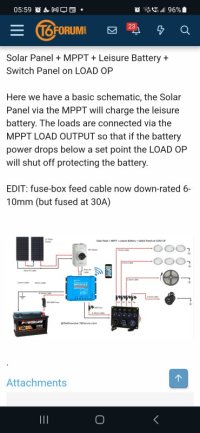QPiepelr65
Ford Transit Connect
Here.
Also to add I plan to do in series as I am loosely following Will Prowses the minimalist setup.
Even though I am following that he gives precious little information about the wiring required which is what I am having most issues figuring out. Also I plan on DC only for now and that setup is using an inverter so not sure how much applies.
So my main question is what size wire do I want for each thing given the powers stated for each item in the image.
The other questions you can see on the top right of the image I posted. Also someone mentioned in a previous post I made to buy and use all one wire gauge to save money. Is this a good idea?
Could I just work out the biggest gauge and then buy a coil of that and use that for everything as over gauge is always good right? Seems like it would be a waste of money if it cost considerably more for thicker wire.
As for the appliances I put in the image I realized that most of those apart from the heater/hob will be on usb ports. I think I recall Prowse say in one of his videos that 10 gauge will be good for most cases. Is that correct here? Here in one of the images is the data for the combihob. It looks similar to usual CDH consumption right? The other things mentioned are low draw too right.
What thickness for the other stuff charge controller to battery and fuse blade to whatever that is meant to connect to? I saw 6mm wire sold on some online stores and, making sure it is copper wire, I was thinking to just buy theirs rather than trying to make mc4 wires myself since they seem pretty commonly available and I can work out the recommended size by what renogy recommends for their panels, which is either 4mm or 6mm solar wire.
So what size wires and what other stuff? For fuses will that all be handled on the fuse blade or do I have to get them for elsewhere too? Do I have to get for the solar panels to mppt or will the circuit breaker be doing that job or is it best to have both circuit breaker and fuse? Anything else to add?
Also, beyond the panels to mppt to battery I am not sure yet how everything connects up but I guess there will be plenty of videos for that. I just want to get my itinerary of kit to buy and try and order in as few orders as I can to save on shipping fees then once I got it I can look up information for each step of the way.
Also to add I plan to do in series as I am loosely following Will Prowses the minimalist setup.
Even though I am following that he gives precious little information about the wiring required which is what I am having most issues figuring out. Also I plan on DC only for now and that setup is using an inverter so not sure how much applies.
So my main question is what size wire do I want for each thing given the powers stated for each item in the image.
The other questions you can see on the top right of the image I posted. Also someone mentioned in a previous post I made to buy and use all one wire gauge to save money. Is this a good idea?
Could I just work out the biggest gauge and then buy a coil of that and use that for everything as over gauge is always good right? Seems like it would be a waste of money if it cost considerably more for thicker wire.
As for the appliances I put in the image I realized that most of those apart from the heater/hob will be on usb ports. I think I recall Prowse say in one of his videos that 10 gauge will be good for most cases. Is that correct here? Here in one of the images is the data for the combihob. It looks similar to usual CDH consumption right? The other things mentioned are low draw too right.
What thickness for the other stuff charge controller to battery and fuse blade to whatever that is meant to connect to? I saw 6mm wire sold on some online stores and, making sure it is copper wire, I was thinking to just buy theirs rather than trying to make mc4 wires myself since they seem pretty commonly available and I can work out the recommended size by what renogy recommends for their panels, which is either 4mm or 6mm solar wire.
So what size wires and what other stuff? For fuses will that all be handled on the fuse blade or do I have to get them for elsewhere too? Do I have to get for the solar panels to mppt or will the circuit breaker be doing that job or is it best to have both circuit breaker and fuse? Anything else to add?
Also, beyond the panels to mppt to battery I am not sure yet how everything connects up but I guess there will be plenty of videos for that. I just want to get my itinerary of kit to buy and try and order in as few orders as I can to save on shipping fees then once I got it I can look up information for each step of the way.


